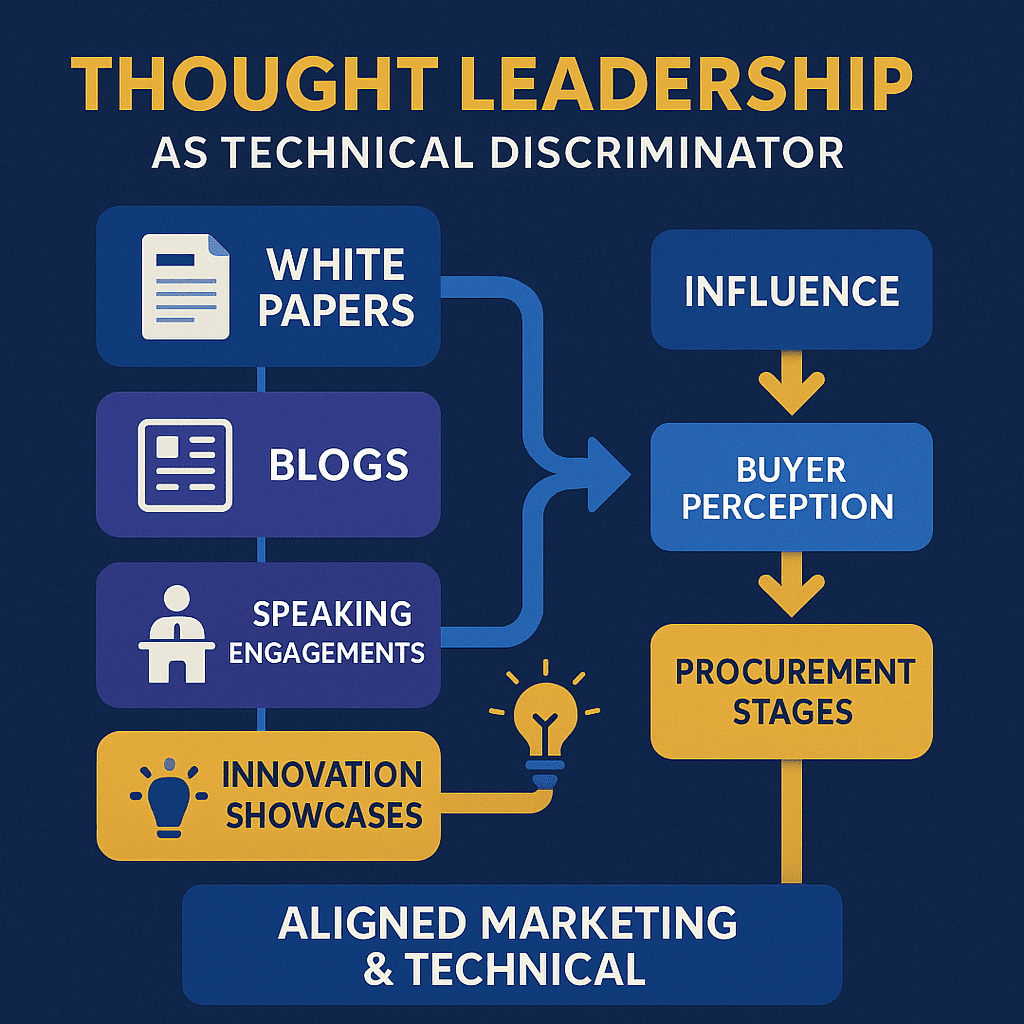In the highly regulated federal market, thought leadership content can be a decisive technical differentiator for small businesses. Federal contracting is fiercely competitive – in fiscal year 2022 alone, small businesses secured $154 billion in federal contracts. To claim a share of that, small contractors must set themselves apart beyond price or past performance. Thought leadership – through white papers, technical blogs, speaking engagements, and innovation showcases – offers a strategic way to build credibility and influence decision-makers with your expertise. By blending strategic insight with tactical execution, small firms can use content to demonstrate they “get it” – that they understand agency missions and have innovative solutions – giving them an edge as a preferred partner. Below, we explore how federal buyers perceive thought leadership, how content shapes early procurement, examples of successful tactics, and tips for aligning marketing and technical teams to produce credible, compliant, and differentiated content.
How Federal Buyers Perceive and Value Thought Leadership
Federal buyers tend to be risk-averse and place a premium on trust and credibility in the decision process. Agencies want to work with contractors who demonstrate a deep understanding of their unique challenges and long-term needs. Establishing your company as an industry authority signals to procurement officials that you are more than just another vendor – you’re a trusted advisor with a forward-thinking approach to government problems. In practice, this means government audiences respond best to content that is relevant, reputable, and concise. A Market Connections survey found that the top qualities federal buyers look for in marketing content are: it addresses their specific interests, it comes from a credible source, and it gets to the point quickly. Busy agency professionals are eager to stay current with technology and industry trends, so timely, insightful content that educates (rather than overtly sells) will stand out in a positive way. Indeed, federal buyers actively seek educational, data-driven insights – e.g. research findings, technical analysis, and past performance examples – and shy away from salesy messaging in vendor content. In short, demonstrating thought leadership through high-quality content builds the credibility and trust that heavily influence federal evaluations. Agencies perceiving your firm as knowledgeable and mission-focused may be more confident in your solutions, tipping the scales in your favor when contracts are awarded.
Did You Know? Federal decision-makers ranked research reports, product demos, and white papers as the most valuable content when determining solutions and selecting vendors. Early in the buying process, they rely on data-rich, educational content to define their requirements – giving thought-leading companies an opportunity to shape the discussion.
Content’s Role in Shaping Early Procurement Influence
Thought leadership content is not just about marketing – it’s a tool for early influence in procurement. Long before a Request for Proposal (RFP) is finalized, agencies are conducting market research and forming opinions. This is where small contractors can punch above their weight by “shaping” the opportunity with insightful content. Procurement shaping is the practice of engaging early to influence how contract requirements are defined, and sharing thought leadership is a key part of that strategy. For example, if a target agency issues a Request for Information (RFI) or hints at an emerging need, a savvy small business might respond by publishing blogs or brief white papers on topics directly related to that need. By posting content relevant to an upcoming RFI, you tie your company’s expertise to the agency’s requirements and position your team as an expert resource in that area. Done correctly, this can make the customer think, “I remember that firm – they understand what we’re trying to accomplish.” In fact, marketers and capture teams strive to reach the point where agency stakeholders recognize their thought leadership throughout the procurement process and feel “they get it”.
Small businesses can also influence early-stage thinking by addressing pain points in their content. Government buyers often start defining solutions by reading industry analysis. Studies show that when agencies are determining the solutions and specifications they need, they highly value the educational content found in industry research reports and white papers. Providing actionable insights or innovative ideas in these formats can subtly shape the customer’s vision of the project – possibly even influencing the RFP’s scope or evaluation criteria in ways that play to your strengths. In one capture planning guide, experts advise contractors to “seed the market” with blogs, articles, and white papers on the key issues related to a forthcoming bid, so that your company’s perspective becomes familiar to decision-makers. By the time the formal solicitation drops, those decision-makers may have already been exposed to your ideas and view your firm as a thought leader in the domain. This kind of early content-driven influence can reduce competition and increase win probability, effectively “wiring in” your discriminators (unique strengths) before proposals are even submitted.
Successful Thought Leadership Tactics for Small GovCon Teams
What does thought leadership look like in practice for a small government contractor? It involves a mix of content formats and outreach efforts that showcase your technical expertise and innovative approach. Here are some tried-and-true tactics that small businesses have successfully used to differentiate themselves:
-
White Papers: Authoritative white papers allow a deep dive into a problem and your solution. Craft these to address specific agency challenges and offer informed answers backed by data. A well-written federal white paper is not a sales brochure – it’s an educational, often technical, document that demonstrates your understanding of the mission need and how to solve it. White papers help establish credibility and confidence with decision-makers, often “influencing procurement decisions” by communicating your value in an in-depth yet credible way. For instance, a small IT contractor might publish a white paper on zero-trust architecture for government networks, showcasing novel approaches to cybersecurity compliance. If timed well, such a paper can circulate among agency IT leaders and position the company as a go-to expert when that agency later seeks solutions in that area.
-
Technical Blogs & Case Studies: Maintaining a regular technical blog (or producing case study articles) is a lighter-weight way to broadcast your expertise consistently. Short-form posts can comment on new policies, emerging technologies, or lessons learned from projects, keeping your firm’s name in front of the federal audience. The key is to keep blogs educational and relevant to government concerns – share tips, analyses, or how-tos that a program manager would find useful, not self-promotional fluff. For example, a small engineering firm could write a blog series on Section 508 accessibility compliance, providing guidance that agency officials find valuable. Over time, this builds your reputation as a knowledgeable partner. (And as a bonus, these posts can be repurposed in proposal writing to show a rich understanding of the issues.) Additionally, publishing case studies of past projects – describing how you solved a problem for a government client – serves as thought leadership by example. Federal buyers highly appreciate content that includes proof points and past performance as it directly speaks to credibility. A concise case study on how your team improved an agency’s cloud implementation, for instance, can both teach and subtly market your capabilities.
-
Speaking Engagements & Panels: There is tremendous value in getting your experts in front of an audience of government stakeholders. Speaking engagements at industry conferences, agency vendor days, or webinars allow you to demonstrate expertise in person (or live online). Small businesses have successfully raised their profile by volunteering to speak on panels or give talks on specialized topics – for example, an 8(a) tech firm might present at an AFCEA conference about using AI for public-sector logistics. These appearances build credibility not only with the attendees but often get noticed by others through event publicity. According to marketing experts, participating in relevant conferences is a powerful way to showcase deep industry knowledge while making valuable connections with procurement officers and program managers in the audience. Even a single well-placed speaking slot can lead to follow-up meetings or inclusion in industry roundtables. Over time, agency buyers start associating your personnel with cutting-edge ideas or reliable expertise in your field – which can be a significant discriminator when past performance among competitors is equal.
-
Innovation Showcases & Tech Demonstrations: Federal agencies are increasingly hosting innovation days, tech expos, and challenge programs to seek out new solutions – prime opportunities for small businesses to shine. Taking part in innovation showcases (such as those run by defense labs or civilian technology offices) allows you to put your solution directly in front of government evaluators in a live demo setting. For example, the Department of Defense’s Tradewind initiative creates events and marketplaces for vendors to showcase innovative solutions directly to defense officials. A small business that gets into an innovation showcase can demonstrate its prototype or approach hands-on, often generating buzz if the solution is truly novel. These venues double as thought leadership platforms: you are not just selling a product, you’re educating officials about what’s possible technologically. Even if a showcase doesn’t result in an immediate contract, it plants a seed with agency stakeholders. Many firms have found that by regularly participating in such events (or presenting at government innovation forums like NIH’s technology showcase, DOE innovation days, etc.), they build a name as forward-thinking problem solvers, which can later differentiate them in competitive procurements. At minimum, networking at these events often leads to partnerships or subcontracts, extending your influence.
-
Targeted PR and Media Outreach: Don’t overlook the value of getting your thought leadership content into trade media or government publications. A single bylined article in a respected outlet (e.g. Federal Computer Week or Defense News) can drastically amplify a small firm’s visibility. Small contractors have used press releases, interviews, and op-eds to punch above their weight. For example, one mid-tier IT contractor worked with a PR firm to regularly contribute expert commentary and contract news to Washington-area publications. In one year, their thought leadership campaign garnered over 12 million impressions in federal trade press and even landed their COO on the cover of Washington Technology. This media exposure significantly raised the company’s profile among both government customers and larger primes. In fact, the visibility was credited with positioning the firm as a serious contender (and eventual winner) for a major U.S. Army IT contract. The lesson for small businesses is that strategic PR – aligning your message with what federal outlets find newsworthy – can dramatically extend the reach of your thought leadership content. It puts your name and ideas in front of influencers who may not stumble on your website or events otherwise.
Aligning Marketing and Technical Teams to Produce Credible, Compliant Content
To execute the above tactics effectively, small businesses must tighten the collaboration between their marketing and technical teams. Thought leadership content sits at the intersection of deep technical insight and polished messaging – it requires both sides to work in unison. Here are some tips to ensure your marketing and technical (and compliance) personnel are aligned in producing content that is credible, compliant, and differentiated:
-
Start Collaboration Early: In the world of government contracting, marketing often needs to be involved far earlier than in commercial sales. Bring your marketing/communications team into the capture process from Day One of pursuing an opportunity. When marketing and capture (technical) teams brainstorm win strategies together from the outset, you’ll develop stronger win themes and more effectively highlight discriminators in your content. Early collaboration ensures that marketers understand the technical value propositions and can begin planning blogs, white papers, or media pitches that reinforce those points well before an RFP is released. As one industry veteran put it, marketing and PR can “sprinkle the target market with exactly the key messages that are important to a major procurement effort” – but only if they know those key messages in advance. So, engage marketing in capture planning and solution discussions, not just after the proposal is written.
-
Translate Technical Knowledge into Key Messages: Technical experts often have great ideas that need refining for a broader audience. Encourage your marketing writers to interview engineers, scientists, or project managers to extract valuable insights which can be turned into compelling content. Likewise, have your technical team review and contribute to content drafts to ensure accuracy and depth. The goal is to translate complex technical capabilities into clear, mission-focused messages that resonate with government readers. For instance, if your technical team identifies a “win theme” (say a unique algorithm that speeds up data analysis), marketing should help articulate why that matters for the agency (e.g. “enables real-time situational awareness for better decision-making”). By working together, you ensure that white papers and blogs aren’t dumbed down or filled with jargon – instead, they hit the sweet spot of being accessible yet technically credible. This alignment also helps marketing stay “on message”: all content, whether a blog or a conference speech, should echo the same differentiators and value propositions that your technical team is emphasizing in proposals. Consistency across channels strengthens your overall positioning.
-
Ensure Content is Credible and Compliant: Small contractors must be especially vigilant that their content is factually correct and follows government ethics and compliance rules. Marketing and technical/legal teams should implement a rigorous review process for all thought leadership materials. Technical staff can verify that any claims or data are accurate and supportable (with citations or evidence), while someone versed in federal compliance should check that nothing violates regulations or goes beyond what is allowed in pre-solicitation communications. Misleading or exaggerated claims are a huge no-go in this space – not only could they damage your reputation, they could even lead to legal trouble if they constitute false statements. For example, claiming your product is certified or tested when it’s not could invoke False Claims Act risks. Similarly, marketing must be mindful of the Federal Acquisition Regulation (FAR) advertising rules and any agency-specific guidelines on vendor communications. Always align your content with reality and with contract requirements – credibility comes from honesty. A good practice is to have your CTO or lead engineer and your contracts/legal adviser sign off on any externally published technical content. This cross-check ensures you maintain an authoritative tone without crossing lines. The payoff is content that government buyers find trustworthy (because it’s backed by real expertise and data) and compliant (so it never jeopardizes your eligibility). Credible, compliance-checked content will reinforce your integrity as a contractor in the eyes of federal evaluators.
-
Leverage Each Team’s Strengths: Finally, make sure to utilize the unique strengths of both marketing and technical personnel. Marketers can help package and promote the content for maximum visibility – for instance, using SEO keywords so that a white paper on cloud security gets found by agency officials searching online, or posting thought pieces to LinkedIn where many federal buyers network (LinkedIn is the top social media platform for reaching federal audiences). Meanwhile, technical team members can serve as subject matter experts who author bylined articles or speak at events (with coaching from marketing on presentation skills if needed). When a potential customer sees a cohesive presence – your engineers writing guest articles, your CEO speaking at events, your company blog regularly updating with insightful posts – it reflects an internal alignment and consistency. This unity greatly boosts the credibility of your thought leadership. It shows that “they all speak the customer’s language and understand the mission”, which is a powerful differentiator. In essence, by tightly aligning marketing and technical efforts, even a small business can project big ideas and reliable expertise through its content, instilling confidence in federal buyers.
By using thought leadership as a technical discriminator, small government contractors can level the playing field against larger competitors. When you consistently produce content that educates and inspires – while highlighting your unique capabilities – you shape the narrative instead of being just another name in a proposal stack. Federal agencies, for their part, take notice of vendors who contribute valuable insights to the community. Early influence through content can position your firm as the standard-setter, the company that defines the problem and the solution. The result is a stronger strategic position when bids come around, bolstered by the trust and mindshare you’ve built over time. In summary: thought leadership is not just marketing fluff; it’s a mission-aligned strategy for demonstrating technical superiority and reliability. By aligning your marketing and technical teams to execute credible, compliant, and impactful content, your small business can present itself as a partner of choice – one that brings not only the required services, but also fresh ideas, domain knowledge, and leadership to the table. In the federal market, that can make all the difference between blending in and winning big.
Sources:
-
Bluetext – “ Establishing Authority: The Impact of Thought Leadership in Government Contracting”
-
Fed Contract Pros – “White Papers for the Federal Government Customer” fedcontractpros.com
-
Market Connections via Boscobel – “Top 7 Federal Content Marketing Takeaways” boscobel.com
-
Hinz Consulting – “Procurement Shaping: Influencing Government Contracts” hinzconsulting.com
-
Boscobel Marketing (White Paper) – “Aligning Marketing, BD, Capture & Proposals” boscobel.com
-
Cross & Crown – “Hidden Challenges of Marketing for Gov Contractors” cacpro.com
-
USFCR – “Leveraging Social Media to Succeed in Federal Contracting” blogs.usfcr.com
-
Squared Compass – “Tradewind Marketplace Unlocking DoD Contracts for Small Businesses” squaredcompass.com
-
Boscobel Case Study – NCI Media Campaign Results boscobel.com




